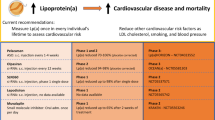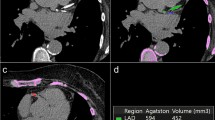Abstract
Purpose The aim of this study was to assess the atherosclerotic plaques in a large asymptomatic population stratified based on age and sex. Methods [18F]-2-fluoro-2-deoxy-d-glucose (FDG)-PET/CT of 100 men and 100 women, divided in four age groups were examined to assess FDG-accumulating active, calcified inactive and mixed atherosclerotic plaques in eight defined vessel segments. Results There was a high correlation between the total number of cardiovascular risk factors and the number of FDG-accumulating active plaques as well as the number of calcified inactive plaques. There was a significant difference in the number of plaques between all age-groups except for active plaques in age groups 60–70 and 80–90 years. Conclusions There is a correlation between the number of cardiovascular risk factors and the number of FDG-accumulating atherosclerotic lesions in this patient material. Statin-treatment was associated with significantly lower numbers of active plaques.






Similar content being viewed by others
References
Libby P (2002) Inflammation in atherosclerosis. Nature 420(6917):868–874. doi:10.1038/nature01323
Spagnoli LG, Bonanno E, Sangiorgi G et al (2007) Role of inflammation in atherosclerosis. J Nucl Med 48(11):1800–1815. doi:10.2967/jnumed.107.038661
Davies MJ (1995) Stability and instability: two faces of coronary atherosclerosis. The Paul Dudley White Lecture. Circulation 94:2013–2020
Fishbein MC, Siegel RJ (1996) How big are coronary atherosclerotic plaques that rupture? Circulation 94(10):2662–2666
Libby P (2006) Atherosclerosis: disease biology affecting the coronary vasculature. Am J Cardiol 98(12A):3Q–9Q. doi:10.1016/j.amjcard.2006.09.020
Tang T, Howarth SP, Miller SR et al (2006) Assessment of inflammatory burden contralateral to the symptomatic carotid stenosis using high-resolution ultrasmall, superparamagnetic iron oxide-enhanced MRI. Stroke 37(9):2266–2270. doi:10.1161/01.STR.0000236063.47539.99
Saam T, Yuan C, Chu B et al (2007) Predictors of carotid atherosclerotic plaque progression as measured by noninvasive magnetic resonance imaging. Atherosclerosis 194(2):e34–e42. doi:10.1016/j.atherosclerosis.2006.08.016
Hyafil F, Cornily JC, Feig JE et al (2007) Noninvasive detection of macrophages using a nanoparticulate contrast agent for computed tomography. Nat Med 13(5):636–641. doi:10.1038/nm1571
Bleeker-Rovers CP, Bredie SJ, van der Meer JW et al (2003) F-18-fluorodeoxyglucose positron emission tomography in diagnosis and follow-up of patients with different types of vasculitis. Neth J Med 61(10):323–329
Blockmans D, De Ceuninck L, Vanderschueren S et al (2007) Repetitive 18-fluorodeoxyglucose positron emission tomography in isolated polymyalgia rheumatica: a prospective study in 35 patients. Rheumatology (Oxford) 46(4):672–677. doi:10.1093/rheumatology/kel376
Lederman RJ, Raylman RR, Fisher SJ et al (2001) Detection of atherosclerosis using a novel positron-sensitive probe and 18-fluorodeoxyglucose (FDG). Nucl Med Commun 22(7):747–753. doi:10.1097/00006231-200107000-00004
Ogawa M, Ishino S, Mukai T et al (2004) (18)F-FDG accumulation in atherosclerotic plaques: immunohistochemical and PET imaging study. J Nucl Med 45(7):1245–1250
Rudd JH, Warburton EA, Fryer TD et al (2005) Imaging atherosclerotic plaque inflammation with [18F]-fluorodeoxyglucose positron emission tomography. Circulation 105(23):2708–2711. doi:10.1161/01.CIR.0000020548.60110.76
Davies JR, Rudd JH, Fryer TD et al (2005) Identification of culprit lesions after transient ischemic attack by combined 18F fluorodeoxy-glucose positron-emission tomography and high-resolution magnetic resonance imaging. Stroke 36(12):2642–2647. doi:10.1161/01.STR.0000190896.67743.b1
Tawakol A, Migrino RQ, Bashian GG et al (2006) In vivo 18F-fluorodeoxyglucose positron emission tomography imaging provides a noninvasive measure of carotid plaque inflammation in patients. J Am Coll Cardiol 48(9):1818–1824. doi:10.1016/j.jacc.2006.05.076
Ben-Haim S, Kupzov E, Tamir A, Israel O (2004) Evaluation of 18F-FDG uptake and arterial wall calcifications using 18F-FDG PET/CT. J Nucl Med 45(11):1816–1821
Dunphy MP, Freiman A, Larson SM et al (2005) Association of vascular 18F-FDG uptake with vascular calcification. J Nucl Med 46(8):1278–1284
Tahara N, Kai H, Ishibashi M et al (2006) Simvastatin attenuates plaque inflammation: evaluation by fluorodeoxyglucose positron emission tomography. J Am Coll Cardiol 48(9):1825–1831. doi:10.1016/j.jacc.2006.03.069
Acknowledgment
This study was supported by the Karolinska University Hospital.
Author information
Authors and Affiliations
Corresponding author
Rights and permissions
About this article
Cite this article
Wassélius, J., Larsson, S., Sundin, A. et al. Assessment of inactive, active and mixed atherosclerotic plaques by 18F-FDG-PET; an age group-based correlation with cardiovascular risk factors. Int J Cardiovasc Imaging 25, 133–140 (2009). https://doi.org/10.1007/s10554-008-9366-5
Received:
Accepted:
Published:
Issue Date:
DOI: https://doi.org/10.1007/s10554-008-9366-5




